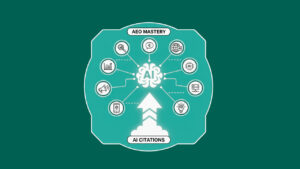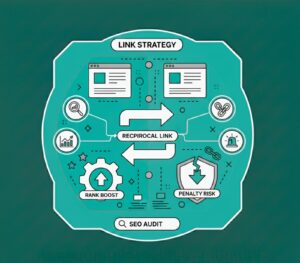AI Content Human Review: Google’s Guidelines for SEO Compliance
Blogs | SEO
Written By: Lauren Davison
Introduction
Imagine publishing a blog that ranks fast but disappears just as quickly. That is what happens when AI writes without a second look. Google does not reward content that feels rushed or robotic. Instead, it values trust, clarity, and relevance.
This is where AI content human review plays its role. A review makes sure writing is accurate, natural, and tailored to the reader instead of just pleasing an algorithm.
If content feels flat, repetitive, or unhelpful, rankings will drop. Google wants writing that serves people, not just machines.
In this blog, we will dive into what Google’s SEO guidelines say, how human review adds real value, and what steps you can take to balance AI efficiency with authentic, search-friendly content.
Table of Contents
Understanding Google’s Stance on AI-Generated Content
AI can churn out text fast. Paragraphs appear in seconds, ideas stack up quickly, and entire drafts can be ready in moments. But Google warns that speed does not replace value. Content must inform, guide, or solve problems. Words alone are not enough. Publishing AI output without checking can lead to mistakes, irrelevant information, or awkward phrasing.
AI does not grasp the reader’s perspective or context. It cannot decide what matters most or how ideas should flow. A careful check ensures the content is accurate, clear, and useful. With this step, machine-generated drafts become trustworthy content that aligns with Google’s quality standards.
Why Human Review Matters
This is where human oversight for AI content becomes crucial. AI can produce sentences, but it cannot verify facts, judge clarity, or make ideas coherent.
Errors, gaps, or off-topic points can slip through unnoticed. A human reviewer can correct these problems. They can adjust wording, organise ideas, and improve readability.
Every paragraph gains purpose and every sentence carries meaning. Proper human oversight transforms raw AI drafts into content that engages readers, builds trust, and performs better in search engines.
Impact on SEO Rankings
AI content that is not reviewed can harm your site’s performance. Search engines notice when text is unclear, inaccurate, or stuffed with filler.
Pages like this often get ignored or ranked lower because they fail to provide real value. Google’s algorithms favour content that humans have checked.
When someone edits a draft, they can fix mistakes, improve flow, and make ideas easier to follow. They can remove irrelevant parts and emphasise the points readers care about. This creates a better experience for visitors.
Unreviewed AI content can feel mechanical or repetitive. Readers may leave quickly, which signals low engagement. Reviewed content is more likely to rank higher and stay visible over time.
Risks of Publishing Unreviewed AI Content
Low-Quality or Inaccurate Information
One major risk of publishing AI content without oversight is factual mistakes. AI can write statements that sound correct but are false. It can also produce shallow ideas that don’t help the reader. Pages like this fail to add real value and can damage trust.
Content quality control solves these issues. Humans can review drafts, fix errors, remove irrelevant parts, and make sure the writing is clear and useful. Proper oversight ensures every sentence matters and the content is reliable. This step improves engagement, protects credibility, and aligns with Google’s quality standards.
Potential Search Penalties
Google’s algorithms are designed to reward content that truly helps readers. Pages written by AI without human checks can fail this test. They rank lower or even disappear from search results if they don’t provide real value.
The helpful content update targets material made mainly for search engines instead of people. Content that feels shallow, irrelevant, or confusing can be deprioritised.
Google also emphasises E-E-A-T: experience, expertise, authoritativeness, and trustworthiness. AI-generated drafts without review can lack these qualities. Facts can be wrong, tone may feel robotic, and context can be missing.
Implementing AI content human review fixes these issues. This step helps pages stay visible, trusted, and valuable in search results.
Brand Reputation and User Trust
AI content published without review can damage a brand quickly. Readers identify errors, confusing sentences, or statements that do not make sense. Once trust is broken, it is hard to regain.
Mistakes in information can make your brand seem careless. Even small inaccuracies reduce authority. Users can stop relying on your site, avoid sharing your content, or question other pages.
Human review fixes these issues. Content that is reviewed carefully builds confidence, keeps readers engaged, and strengthens authority. When your content is reliable, users trust your brand and return repeatedly.
Best Practices for Human Reviewing AI-Generated Content
Fact-Checking and Accuracy
Check all facts carefully. Numbers, dates, and statements can be wrong even if they look right. AI can produce information that seems accurate but is outdated or misleading. Always verify sources and link to trustworthy references.
Look closely at claims. Ask yourself if the point can be proven or backed up. Small mistakes can confuse readers and damage trust. Human reviewers can spot errors, correct unclear wording, and fix details that AI misses.
Fact-checking strengthens credibility. Accurate content builds reader confidence and helps pages perform better in search results. With careful review, AI drafts turn into dependable, useful content rather than guesswork.
Ensuring Readability and Engagement
A human review ensures that sentences are clear and that ideas flow naturally. Short, direct sentences often work better than long, complicated ones.
Tone needs attention. The writing should feel friendly, professional, or approachable, depending on the audience. Words that sound mechanical or impersonal can push readers away.
Structure is key. Headings, lists, and spacing help readers scan the content quickly. Each paragraph should focus on one idea so the message is easy to follow.
Engagement is more than words. Does the content solve a problem? Does it answer questions clearly? Human editors can improve examples, adjust emphasis, and highlight the most useful points. Well-reviewed text keeps readers interested and signals quality to search engines.
Optimising for SEO
Keywords work best when they fit naturally. Use primary and secondary terms where they belong. Headings, opening lines, and key points are good places to start. Meta titles and headings should clearly show what the content is about. Keep them short, simple, and accurate.
Do not overload sentences with keywords. It feels forced and hard to read. Think about the reader first and drop keywords in lightly.
Meta descriptions, links, and image text can also carry keywords, but only if they flow. The main aim is helpful content that makes sense to humans and search engines alike.
Tools and Techniques to Facilitate AI Content Review
Grammar and Readability Checkers
Tools like Grammarly, Hemingway, and Writer.com help during AI content human review. They catch errors, awkward phrasing, and long sentences that slow readers down.
Hemingway points out hard-to-read lines and passive voice, making writing punchy. Grammarly suggests simpler words and a smooth flow.
These tools also aid in AI content verification, highlighting text that can appear to be machine-generated. Use them as guides, not rules. Read the content yourself, tweak where needed, and keep it natural. The aim is writing that feels human, clear, and easy to follow.
SEO Analysis Tools
SEMrush, Surfer SEO, and Clearscope help check what people are searching for. They point out the right keywords and suggest topics readers want. SEMrush shows trends and competitor strategies.
Surfer SEO and Clearscope guide where to place keywords and how to structure text. Using these tools alongside your review keeps content aligned with search intent.
It also makes sure writing feels natural, useful, and easy to read. Don’t rely only on tools; mix their suggestions with your own judgment to make content clear and engaging.
AI Detection and Verification Tools
Detection tools can help check if the content is original. Tools like Originality.ai, Copyleaks, and Turnitin highlight copied or automated text. They spot patterns and phrasing that feel machine-made.
Using these tools gives reviewers a sense of which parts may need rewriting. It is not about replacing judgment; human eyes still decide what reads naturally. This process ensures content stays clear, trustworthy, and easy to follow, while avoiding anything that feels forced or robotic.
Benefits of Combining AI with Human Oversight
Increased Efficiency with Quality Assurance
AI makes the first steps faster, but it does not replace judgment. Humans step in to check facts, smooth awkward phrasing, and make sure content meets Google’s rules.
Editors adjust tone, fix errors, and keep the text useful for readers. The mix of AI speed and human care means content gets done faster without losing clarity or trust. It is a balanced and quick process, but still readable and reliable.
Maintaining SEO Performance
AI can help generate ideas and draft content quickly, but it does not check everything. Human editors step in to fine-tune headings, tweak meta tags, and place keywords where they make sense.
This prevents mistakes that could hurt rankings. It also keeps the writing clear and useful for readers. With both AI and humans working together, content can rank well, stay relevant, and avoid penalties.
Consistent Brand Voice and Authority
Humans check AI-generated content SEO to make sure it feels right. They tweak words, tone, and examples so everything aligns with the brand’s style. This keeps content trustworthy, clear, and consistent.
Readers sense when writing feels natural, and careful editing ensures authority and credibility stay strong. With human oversight, AI drafts turn into content that both performs online and represents the brand well.
Conclusion: Human Review is Non-Negotiable for AI Content
AI can produce drafts quickly, but speed alone cannot guarantee the quality of the drafts. Facts can be wrong, sentences may be unclear, and context can be lost. Human review ensures accuracy, readability, and usefulness.
With AI content human review, errors are caught, tone is adjusted, and content becomes meaningful to readers. This process aligns the material with Google’s standards while keeping it trustworthy and engaging.
At Midland Marketing, we combine AI efficiency with human oversight. AI helps generate content faster, while our team ensures every piece is polished, clear, and authoritative.
This approach strengthens search performance, maintains credibility, and keeps readers engaged. Human review is not optional. It turns raw AI output into content that works, benefiting both users and search engines.
Frequently Asked Questions
1. What is AI-generated content human review?
AI can quickly make text, but it doesn’t always read naturally. People check the meaning, fix sentences, and make it clear. This keeps content readable, accurate, and useful.
2. Why is human review needed for AI content?
AI misses context and tone. Humans spot errors, smooth the flow, and make sure the writing works for real readers. Without it, mistakes can hurt credibility or rankings.
3. How does human review follow Google’s SEO rules?
Google likes content that helps readers. Humans check headings, place keywords naturally, and keep sentences easy to follow. They remove repetition and awkward lines to make the content solid and compliant.
4. Which tools help review AI content?
Grammarly and Hemingway catch grammar and readability issues. SEMrush, Surfer SEO, and Clearscope guide keyword use and structure. Originality.ai or Copyleaks check for copied or automated text, highlighting areas that need human adjustment.
5. Can AI-generated content rank well?
Yes. AI speeds up drafting, but humans polish tone, structure, and flow. The mix keeps content natural, helpful, and SEO-friendly, making it more likely to perform in search results.

Written by - Lauren Davison
Introducing Lauren – one of our content writers who has a flair for SEO and creative strategy!
With a Master’s Degree in Creative Writing, Lauren has niched down into SEO and content writing.
Outside of work, she loves watching the darts, reading and the pub on the weekend.
Want some more?
Latest Insights & News

Revolutionising Marketing: The Rise of Situational Content Strategies
Situational content strategies involve tailoring content to specific moments, contexts, or audience behaviours. By aligning content with real-time trends, seasonal needs, and user intent, brands can increase relevance, improve engagement, and strengthen SEO performance.

Smart Ways to Identify and Fill Content Gaps Fast: A Complete Strategy Guide
Content gaps refer to missing information, unanswered questions, or underserved topics in your existing content. Identifying these gaps helps you create targeted, high-value pages that improve search visibility, satisfy user intent, and outperform competitors.

Reciprocal Links in SEO: Do They Still Boost Rankings or Risk Penalties?
For the keyword “reciprocal links SEO,” focus on explaining how reciprocal linking works today. Reciprocal links are not harmful by default, but Google can flag excessive or manipulative link exchanges. To stay safe, only exchange links when they are contextually relevant, natural, and valuable to users.
